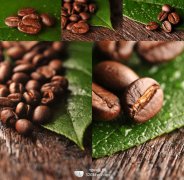Analysis on the steps of Coffee Baking

Once the coffee seed is planted, no one can change its final quality. However, the color, aroma, bioactive components and health characteristics of coffee are related to the roasting process. In the process of roasting, coffee is heated at 190-220 °for 7-20 minutes, which helps to bake out its aroma and good taste. It also helps to form lactone, nicotinic acid, coffee tannic acid with antioxidant effect, caffeine and other health-beneficial compounds and trace elements.
Caffeine is the only substance that remains unchanged throughout the baking process, but huge, complex and not yet fully understood chemical changes in coffee beans cause about 25% of their weight loss. During the baking process, the color of coffee beans changes from green to yellow, then to brown, and finally to brown. The process from yellow to brown is often referred to as the first burst, because a popcorn-like popcorn popping sound occurs at about 160 degrees, when the coffee beans more than double in size, turn light brown, and lose about 5% of their weight. The coffee bean expands to 150% of its original volume, and caramelization begins inside the bean.
Next, the temperature rises from 205 °to about 220 °, the color of the coffee changes from light brown to medium brown, and there is about 15% weightlessness. This chemical process is called high-temperature decomposition, in which the chemical composition of coffee beans changes and releases carbon dioxide. After the first burst, there is a pause, followed by a brief endothermic process, followed by a chemical reaction, followed by an exothermic process known as the second burst. The second high temperature decomposition occurs at 225 °and the color changes to a moderate black-brown color.
The second burst is faster, and the coffee beans show an oily luster and become fragile, and at this stage, its ingredients begin to carbonize, resulting in charred properties. The smell of coffee can be smelled before the first burst. The first burst reflects the physical stretch of coffee and the chemical reactions of the compounds associated with it, such as the formation of water and the release of carbon dioxide. When the temperature reaches its peak, a second burst occurs, when the cellulose, matrix and coffee beans all begin to break.
The darker the robusta beans are baked, the more delicious they are; the darker the Arabica beans are baked, the more delicious and special they lose. On the other hand, medium baking can make their delicacies well displayed.
The automatic sorting machine separates high-quality coffee beans from many coffee beans, removes beans that are too light or too black, and applies very sophisticated production control techniques to reduce the percentage of unqualified coffee beans, including: ultraviolet fluorescence analyzer, identify moldy beans; trichromatic light mapping technology produces color fingerprints (yellow-green, red and infrared) for each coffee bean.
Soluble coffee needs vacuum packaging because it has strong water absorption. In roasted coffee, soluble coffee does not contain a lot of volatile substances, and most soluble coffee is made from robusta coffee. Robusta coffee is cheaper and contains more caffeine than Arabica coffee.
Important Notice :
前街咖啡 FrontStreet Coffee has moved to new addredd:
FrontStreet Coffee Address: 315,Donghua East Road,GuangZhou
Tel:020 38364473
- Prev

The basic chemical reactions that take place during coffee roasting
Many thermal and chemical reactions take place during baking: decarbonation, dehydration of quinic acid, subdivision, isomerization, polymerization, and complex sugar reactions (caramelization). The main components of the thermal reaction are monosaccharides and sucrose, chlorogenic acid, free amino acids, and fenugreek amide. Both aravinose and calactose in the polysaccharides are transferred, and the basic vulcanization process includes hydroxylamine.
- Next

Introduction to roasting of coffee beans
One: coffee bean roasting purpose: 1: aroma 2: increase the complexity of coffee 3: to obtain color 4: to form the unique flavor of coffee and other functions. Second, the roasting method of coffee beans is divided into: fast roasting (the shortest time is 90 seconds, the traditional time is 12 minutes) slow roasting (12 minutes-40 minutes) three: coffee roasting has the following degrees: 1: shallow roasting
Related
- What documents do you need to go through to open a coffee shop? coffee shop coffee shop certificate processing process
- How to purchase Coffee beans in small Cafe how to choose a suitable supplier for domestic Coffee supply Company
- How to drink Starbucks Fragrance White Coffee? how to make Australian White Coffee? what Italian coffee beans are recommended?
- The Story of Flora Coffee: the name of Flora Coffee Bean and the implication of the Flowers on Florna Coffee
- How much does a cup of coffee cost? How much is the profit of a cup of coffee? What is the profit of the coffee shop in a year?
- Yunnan small Coffee, known as "fragrant Coffee", introduces the characteristics of Alpine Arabica Coffee producing areas in Yunnan, China
- 2023 latest Starbucks full menu price list how much is a cup of Starbucks coffee what is better to drink the most popular hot and cold drinks recommended
- Starbucks different kinds of Coffee Price list Starbucks menu 2023 Top Ten Best drinks in Starbucks
- Starbucks Spring praise Comprehensive matching Coffee Bean theme Story Packaging implication and taste description
- The cost of a cup of coffee latte American coffee cost price and selling price

